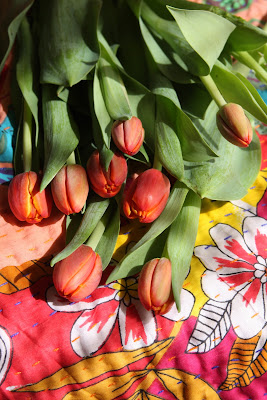Spring? On the back burner in Michigan
Spring fever? Not until it warms up here in Michigan.
It’s been unseasonably, if not unspeakably cold here, with temperatures barely climbing out of the 20’s. In search of signs of life in the garden, I take (brisk!) walks around the flower beds, only to find evidence of deer and rabbits having a field day nibbling the tender buds of my crocuses and hyacinths. Under the winter-worn brambles of the blackberry bushes, one lonely blossom... so sad and brave out there.
Awaiting Spring, there’s always the market where hope springs. Eternal. Here asparagus stalks. Rhubarb abounds. And strawberries are always in season.
Now according the Epicurious Seasonal Ingredient Map, cabbage and broccoli are the go-to produce of Michigan in the month of March. (?) According to the Michigan Produce Availability Calendar, we’re still in cold crop mode with the offerings of evergreens, mushrooms, onions and potatoes.
Looking for luscious Spring colors, bending the rules of play for the Open Salon Kitchen Challenge, I throw geography to the wind, and choose produce from every-which-way, starting off with a ruby red head of cabbage from Michigan or who-know-where. Gorgeous.
In the basket goes another head of cabbage -- pale green, then a fennel bulb (in season in Louisiana) and bright carrots (in season in North Carolina) Add shallots and leeks, along with a sprig of rosemary, a pound of dried Great Northern beans, and a few slices of pancetta. . .
Now what to make of this? Ahh, I know just the thing. Ribollita!
“Suppa Toscana,” the classic bread soup of Tuscany.
Talk about peasant stock, ribollita (ree-boh-LEE-tah), literally “reboiled” soup, is thick and yummy, and an excellent use of leftover soup stock, vegetables, canned tomatoes, you name it. The secret of a good ribollita is slow cooking. On low simmer, on the back burner, the mix of vegetables and beans thickens into a heady, hearty aromatic sort of stew. I’ve had the real deal in Italy, on a Trek Bike Tour through Tuscany, and I can tell you, the dish is well worth the sore saddle and 40-mile climb up and down steep hills.
According to The Dictionary of Italian Food and Drink (John Mariani) ribollita is traditionally made with cannellini (Great Northern) beans, olive oil, red cabbage and vegetables (of your choosing), bread and cheese, left to stand, and reheated. It is traditionally served thick enough to eat with a fork. Sometimes it is referred to a suppa del cane (soup of the dog) because of its simplicity.
There are many different recipes for ribollita on line. The method is simple enough and most every combination of greens and beans and tomatoes are fine. Ribolitta can be reheated or reconstituted with new stock or vegetables the next day for a whole new version. I’ve taken a sampling of several recipes, so follow the recipe below according to your taste and discretion:
Ingredients
- 1 cup dried cannellini or Great Northern beans
- About 2 cups red cabbage, shredded
- About 2 cups green cabbage or chard, shredded
- 1/4 up extra-virgin olive oil
- 1 leek, sliced
- 1 onion, chopped
- 2 carrots, chopped
- 2 potatoes
- 4 ounces pancetta, chopped
- 4 cloves garlic, minced
- 1 teaspoon salt
- 1 teaspoon freshly ground black pepper
- 1 (15-ounce) can diced tomatoes
- 3 to 4 cups chicken stock
- 1 sprig fresh rosemary
- 1 teaspoon dried oregano
- 1 bay leaf
- 1/2 Parmesan, grated
- 1/2 loaf ciabatta bread, sliced and cubed
Here’s what you do:
Pre-soak beans in water for 8 hours or over night. Drain and rinse.
Faster method: Rinse beans and place in large, heavy saucepan with the garlic cloves, bay leaf, and cover with water. Bring to a boil, reduce heat and cook at a simmer for about an hour or until the beans are tender, adding more water as needed. Remove the bay leaf and let the beans cool. Puree half the beans in a food processor.
Heat olive oil in a large casserole or cast iron pot with a cover.
Saute the garlic, onion and pancetta until onion is golden brown and pancetta is crisp. Add the chopped carrot, leek, potatoes, salt and pepper. Add tomatoes and stir, scraping the bottom of the pan with a wooden spoon to release all the brown bits. Add the cabbage, beans, herbs, stock, and bay leaf. Bring to a very slow simmer and cook for about 1 1/2 hours. Add bread cubes and parmesan to the soup, mix and heat in oven for 20 minutes.
An alternative method for serving soup less thick,: instead of adding bread to soup, drizzle olive oil on ciabatta bread slices, toast in oven. Place in individual bowls and ladle soup over toast to serve.
First a howling blizzard woke us,
Then the rain came down to soak us,
And now before the eye can focus -
Crocus.
~Lilja Rogers
With memories of Tuscany...
Thanks for dropping by












Comments
Post a Comment